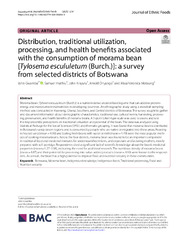| dc.contributor.author | Gwamba, John | |
| dc.contributor.author | Imathiu, Samuel | |
| dc.contributor.author | Kinyuru, John | |
| dc.contributor.author | Onyango, Arnold | |
| dc.contributor.author | Motaung, Masa Veronica | |
| dc.date.accessioned | 2025-08-28T07:37:24Z | |
| dc.date.available | 2025-08-28T07:37:24Z | |
| dc.date.issued | 2025-02-03 | |
| dc.identifier.citation | Gwamba, J., Imathiu, S., Kinyuru, J., Onyango, A., & Motaung, M. V. (2025). Distribution, traditional utilization, processing, and health benefits associated with the consumption of morama bean [Tylosema escululetum (Burch.)]: a survey from selected districts of Botswana. Journal of Ethnic Foods, 12(1), 4. | en_US |
| dc.identifier.issn | 2352-619X | |
| dc.identifier.uri | https://link.springer.com/article/10.1186/s42779-024-00264-0?utm_source=getftr&utm_medium=getftr&utm_campaign=getftr_pilot&getft_integrator=scopus | |
| dc.identifier.uri | https://hdl.handle.net/13049/798 | |
| dc.description.abstract | Morama bean [Tylosema escululetum (Burch.)] is a nutrient-dense underutilized legume that can address protein-energy and micronutrient malnutrition in developing countries. An ethnographic study using a snowball sampling method was conducted in Kweneng, Ghanzi, Southern, and Central districts of Botswana. The survey sought to gather and document information about demographic characteristics, traditional use, cultural norms, harvesting, processing, preservation, and health benefits of morama beans. A 5-point Likert-type scale was used to assess and rate the respondent(s) perceptions on traditional utilization and potential of the bean. The data was analyzed using Statistical Package for the Social Sciences (SPSS) and thematic grouping. It was found that morama bean is distributed in Botswana's sandy desert regions and is consumed by people who are native or migrated into these areas. Roasting in heated sand (mean = 4.93) and boiling fresh beans with water or milk (mean = 4.49) were the most popular methods of cooking morama beans. Across the four districts, morama bean was found to be an important component in traditional food and medicinal mixtures for undernourished infants, and expectant and lactating mothers, mostly prepared with soft porridge. Respondents cited a significant lack of scientific knowledge about the bean's medicinal properties (mean = 1.27–1.38), indicating the need for additional research. The nutritious density of morama beans (mean = 4.87) and their potential for processing into value-added products (mean = 4.10) were known to the respondents. As a result, the bean has a high potential to improve food and nutrition security in these communities. | en_US |
| dc.description.sponsorship | Botswana University of Agriculture and Natural Resources | en_US |
| dc.language.iso | en | en_US |
| dc.publisher | Springer Nature Link | en_US |
| dc.relation.ispartofseries | Journal of Ethnic Foods;Volume 12, article number 4, (2025) | |
| dc.subject | Botswana | en_US |
| dc.subject | Morama beans | en_US |
| dc.subject | Indigenous knowledge | en_US |
| dc.subject | Indigenous foods | en_US |
| dc.subject | Traditional processing | en_US |
| dc.subject | Food and Nutrition security | en_US |
| dc.title | Distribution, traditional utilization, processing, and health benefits associated with the consumption of morama bean [Tylosema escululetum (Burch.)]: a survey from selected districts of Botswana | en_US |
| dc.type | Article | en_US |

